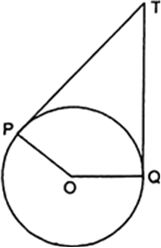Constructions
If tangents PA and PB from a point P to a circle with centre O are inclined to each other at angle of 80°, then ∠ POA is equal to
(A) 50° (B) 60°
(C) 70° (D) 80°.
In ΔPOA and ΔPOB
PA = PB
(Tangents from external point P)
OA = OB (Radii of a circle)
and OP = OP (common)
∴ ΔPOA ≅ ΔPOB
(by SSS congruency)
⇒ ∠OPA = ∠OPB
⇒ ∠OPA = ∠OPB = 40°
Since, the tangent at any point of a circle is perpendicular to the radius through the point of contact.
∴ ∠OAP = 90°
Now, in ΔOAP,
∠OAP + ∠OPA + ∠POA = 180°
⇒ 90° + 40° + ∠POA = 180°
⇒ 130 + ∠POA = 180°
⇒ ∠POA = 50°
So, right option is (A).
Sponsor Area
Some More Questions From Constructions Chapter
The common point of a tangent and the circle is called ____________.
In Fig. 10.11, if TP and TQ are the two tangents to a circle with centre O so that ∠ POQ = 110°, then ∠ PTQ is equal to
(A) 60° (B) 70°
(C) 80° (D) 90°
Fig. 10.11
If tangents PA and PB from a point P to a circle with centre O are inclined to each other at angle of 80°, then ∠ POA is equal to
(A) 50° (B) 60°
(C) 70° (D) 80°.
Prove that the tangents drawn at the ends of a diameter of a circle are parallel.
Prove that the perpendicular at the point of contact to the tangent to a circle passes through the centre.
The length of a tangent from a point A at distance 5 cm from the centre of the circle is 4 cm. Find the radius of the circle.
Two concentric circles are of radii 5 cm and 3 cm. Find the length of the chord of the larger circle which touches the smaller circle.
A quadrilateral ABCD is drawn to circumscribe a circle. Prove that
AB + CD = AD + BC.
Mock Test Series
Sponsor Area
NCERT Book Store
NCERT Sample Papers
Sponsor Area